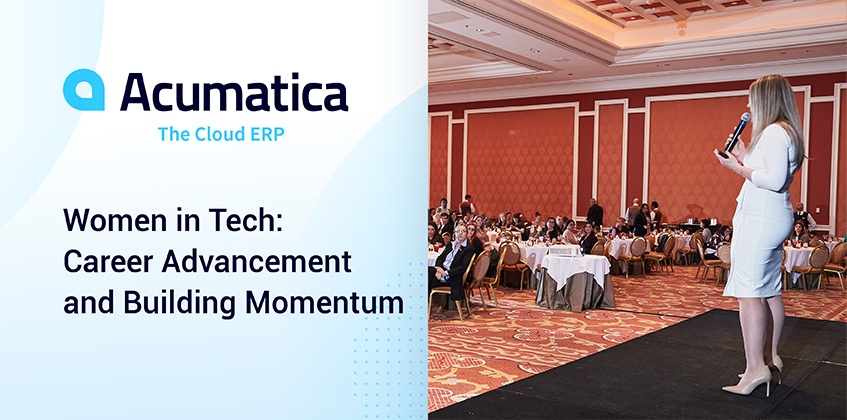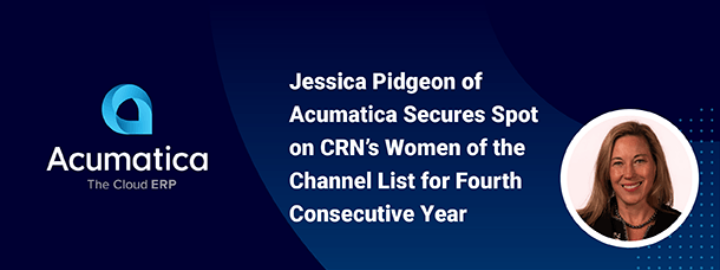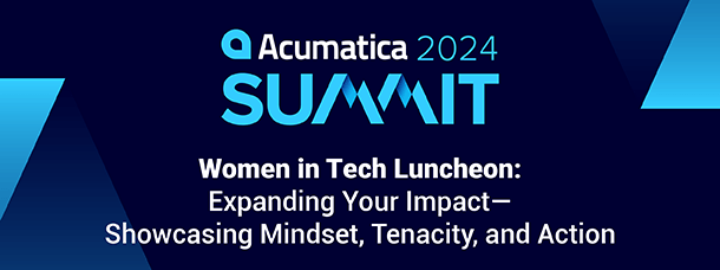
As part of our AcumatiCares diversity, equity, and inclusion (DEI) initiatives, Acumatica is committed to seeing women promoted, rewarded, and elevated in the tech industry. Our annual Acumatica Summit Women in Tech (WiT) Luncheon and Networking Reception is just one instance of this commitment. The event brings women together to learn from, engage with, and inspire one another to achieve their goals in the tech industry. For this engagement to continue year-round, we have created our online WiT Community to encourage connections and conversations that will help support and empower women in the workplace.
Because learning is an important part of building momentum, Acumatica is also sponsoring a set of two WiT webinars, led by award-winning author and founder of Tech Savvy Women, JJ DiGeronimo. The first webinar, “Women in Tech: Career Advancement Starts Within,” can now be watched on-demand. The second webinar, “Career Advancement – Building Momentum,” will be held on October 19, starting at 10:00 AM PT / 1:00 PM ET.
Today, as a preview of the rich dialogue and engaging topics that will be part of this webinar, we’ll talk about three keywords on which companies can focus to empower their female workforce: Access, Sponsorship, and Alignment.
Access: Ensure Accessible Resources and Training
A career is a dual path. Working in your career is different from working on your career. Completing a to-do list of items others have asked you to work on is different from actively pursuing the goals you want to achieve. This is, of course, true for both men and women—in tech or in any industry. But women are more likely to find themselves just working in their careers. Why? A recent study in Psychology of Women Quarterly found an intriguing answer. Of the sample studied, men and women were equally likely to take risks at work, but “women suffered more negative consequences for taking those risks, such as asking for a pay raise, but then being viewed as arrogant or entitled, or asking for support with a difficult task, then being viewed as lacking independence.”
Companies that are truly committed to workplace equity should take measures to eliminate these negative consequences, providing a safe environment for women to speak openly and honestly about their goals. This includes ensuring that female employees have access to all the resources and training materials they need to learn, grow in their positions, and work on their careers. This will involve giving them the opportunities to:
- Develop (and, optionally, share) their visions for their careers.
- Build a network of supportive peers and leaders who are on the same career path.
- Communicate and be recognized for their achievements.
- Create schedules that align with their career goals, not just their managers’ goals for them.
- Develop relationships with sponsors in the organization, who can and want to help them push forward from accomplishment to accomplishment.
And this brings us to the next keyword: Sponsorship.
Sponsorship: Build a Network of Sponsors and Diverse Leadership
At first glance, the words “sponsor” and “mentor” may seem synonymous, but sponsors are more than mentors. As JJ DiGeronimo puts it: “Sponsors are people that make connections for you, speak about you and your goals in rooms you’re not invited to, [and] give you the inside track on how to get things done.”
But women are still less likely to be given high-stakes assignments or promoted to greater leadership positions because they are “over-mentored and under-sponsored.” And the gendered issue doesn’t end there. If female and male sponsors recommend people for the same role, the candidates “recommended by women are less likely to get hired than those who are recommended by men.”
Sponsorship, then, is a critical element of corporate culture. To empower women and help them build momentum in their careers, organizations can focus on building a culture of open, transparent communication that allows women to be seen by and build relationships with potential sponsors.
Alignment: Provide Strengths-based Professional Development Plans
Discussing her research with CNN, Linda Babcock, economics professor at Carnegie Mellon University and co-author of The No Club: Putting a Stop to Women’s Dead-end Work, says that “managers are 50% more likely to ask a woman than a man” to do “invisible tasks.” These are tasks that may ultimately be good for the company—like sitting on committees, mitigating conflicts, etc.—but they are not part of the woman’s job description, skill set, or performance evaluation criteria.
Women are likely to say “yes” to invisible tasks because saying “no” has a significantly negative impact. Women who say “no” are seen as not being team players.
Organizations that want to empower their female workers can actively assign tasks according to who is the best person for the job—not who is least likely to balk at being asked. It is also critical to reward the behind-the-scenes work and bring the invisible tasks to light. When no one is invisible, everyone feels valued. And when employees feel valued, they are more satisfied in their positions, more productive, and more beneficial to their organizations.
Just the Beginning
The keywords we’ve covered here today—Access, Sponsorship, and Alignment—are just the tip of the iceberg. To learn more about how companies can empower women to build career momentum, attend the WiT Luncheon and Networking Reception at Acumatica Summit 2024, join the online WiT Community, and be sure to register for the Career Advancement – Building Momentum webinar on October 19.
 Canada (English)
Canada (English)
 Colombia
Colombia
 Caribbean and Puerto Rico
Caribbean and Puerto Rico
 Ecuador
Ecuador
 India
India
 Indonesia
Indonesia
 Ireland
Ireland
 Malaysia
Malaysia
 Mexico
Mexico
 Panama
Panama
 Peru
Peru
 Philippines
Philippines
 Singapore
Singapore
 South Africa
South Africa
 Sri Lanka
Sri Lanka
 Thailand
Thailand
 United Kingdom
United Kingdom
 United States
United States










